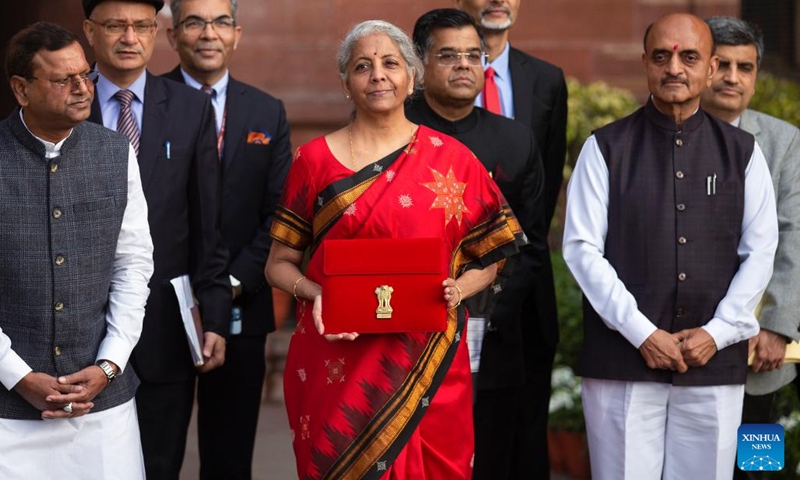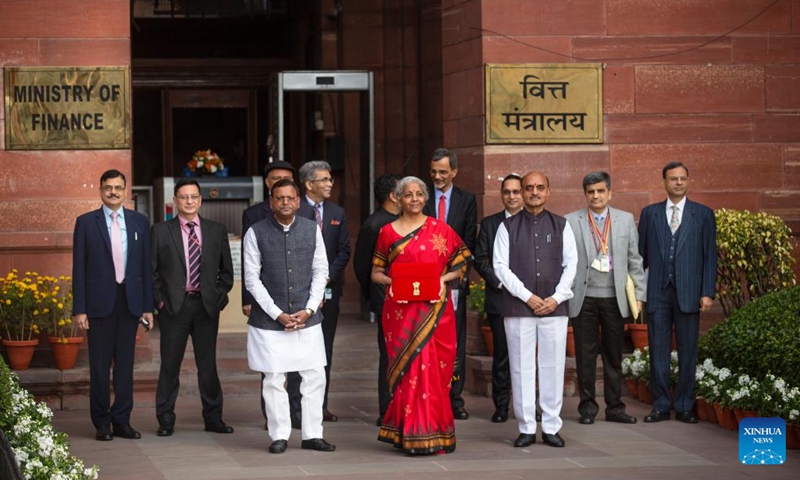
India's Finance Minister Nirmala Sitharaman (C, front) prepares to present the country's General Budget for the 2023-24 fiscal year to the parliament in New Delhi, India, Feb. 1, 2023.(Photo: Xinhua)

India's Finance Minister Nirmala Sitharaman (C, front) prepares to present the country's General Budget for the 2023-24 fiscal year to the parliament in New Delhi, India, Feb. 1, 2023.(Photo: Xinhua)
India's Finance Minister Nirmala Sitharaman on Wednesday presented the country's General Budget for the 2023-24 fiscal year to the parliament.
"Finance Minister Nirmala Sitharaman presented the annual budget and addressed the Lok Sabha, the lower house of parliament," a Finance Ministry official said.
It is Sitharaman's fifth budget as the finance minister.
"This budget hopes to build on the foundation laid in the previous budget, and the blueprint drawn for India at 100, which envisions a prosperous and inclusive India, where the fruits of development reach all regions and citizens, especially our youth, women, farmers, Other Backward Classes (OBCs), Scheduled Castes and Scheduled Tribes," she said.
The finance minister said the Indian economy was on the right track and heading towards a bright future despite a time of challenges.
"The world has recognized the Indian economy as a 'bright star' as the economic growth is estimated at 7 percent, which is the highest among all major economies," in spite of the massive global slowdown caused by COVID-19 and the Russia-Ukraine conflict, she said.
Sitharaman announced that the capital investment outlay will be increased by 33 percent to 122 billion U.S. dollars, which would be 3.3 percent of the GDP.
Money for railway projects saw the highest ever outlay of 29.3 billion U.S. dollars.
According to the minister, the capital outlay is the highest and about nine times the outlay made in 2013-14.
She said 50 additional airports, heliports, water aerodromes and advance landing grounds will be revived for improving regional air connectivity.
To spur investment in infrastructure, she said the government has decided to continue the 50-year interest-free loan to state governments for one more year to incentivize them for complementary policy actions, with a significantly enhanced outlay of 15.9 billion U.S. dollars.
Sitharaman said it is targeting a half percent reduction in its fiscal deficit - the gap between what it earns and spends - from 6.4 percent in 2022-23 to 5.9 percent in 2023-24.
She said the government has pledged to bring the fiscal deficit below 4.5 percent of GDP by 2025-26.
Focussing on the agriculture sector, Sitharaman said an agriculture accelerator fund will be set-up to encourage agri-startups by young entrepreneurs in rural areas. The fund will aim at bringing innovative and affordable solutions for challenges faced by farmers.
She also announced that the agriculture credit target will be increased to 244 billion U.S. dollars, with focus on animal husbandry, dairy and fisheries.
Continuing with the commitment to ensure food and nutrition for the poor, the minister said the government will bear an expenditure of 24.4 billion U.S. dollars to supply free food grain to all poor and priority households for one year. The scheme is being implemented from Jan. 1 this year.
In push for the government's objective of housing for all, she said, an outlay for the Prime Minister's public housing program will be enhanced by 66 percent to over 9.65 billion U.S. dollars.
Sitharaman also announced tax relief measures for India's vast middle class, including an increased threshold for personal income taxes for those who have opted for a new tax regime introduced in 2020.
Indians who earn under 700,000 rupees (8,550 U.S. dollars) a year will not have to pay income tax anymore if they migrate to the new regime.
India's maximum tax on personal income has also been effectively reduced from 42.74 percent to 39 percent.
The move is likely to boost consumption, as it will put money into the hands of people.
The federal budget - annual financial statement of a government - gives details about the revenue and expenditure, besides providing estimates about spending for the coming year.
